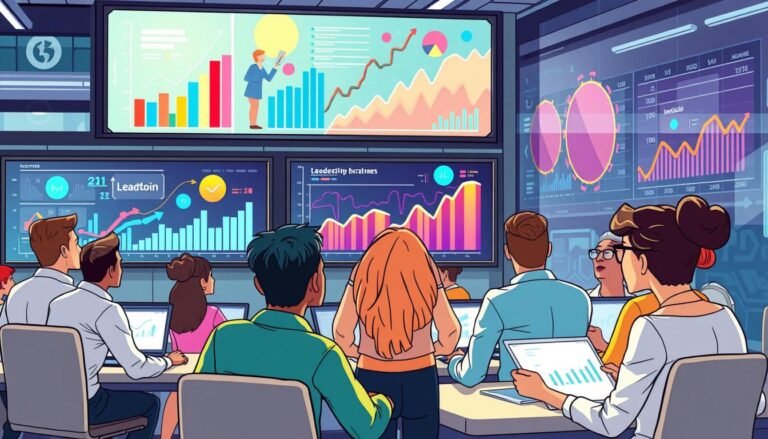Leadership Development Programs
“The growth and development of people is the highest calling of leadership.” – Harvey S. Firestone
In today’s fast-paced business world, leadership development programs are key. They help organizations grow their top talent and succeed. These programs mix executive coaching, management training, and talent management to shape future leaders.
Companies spend over $14 billion on these programs. It shows they see the value in investing in their future leaders. These programs aim to fill the gap between current skills and what leaders need, as 45% of managers feel they lack confidence in helping employees develop.
Good leadership development programs boost employee engagement and keep them around. Since managers play a big role in employee happiness, it’s no wonder 60% of US employees have left or thought about leaving because of their managers.
From Cinépolis to aerospace, financial services, and healthcare, companies are creating custom programs. They use rotational structures, targeted training, and mentorship to grow leaders. These leaders are ready to drive innovation and growth.
Key Takeaways
- Leadership development programs are a $14 billion industry
- 45% of managers lack confidence in developing employee skills
- Managers influence 70% of employee engagement variance
- 60% of US employees consider leaving due to poor management
- Effective programs can increase revenue and employee satisfaction
- Tailored approaches for senior, mid-level, and frontline leaders
- Success metrics include innovation pipelines and engagement scores
Understanding Leadership Development Programs
Leadership development programs are key for growing future leaders. They help build important leadership skills. This ensures a smooth transition of power in companies.
Definition and Core Components
These programs aim to improve leadership skills and prepare people for bigger roles. They include face-to-face training, chances to network, and community involvement. The goal is to enhance strategic thinking, decision-making, and emotional intelligence.
Types of Development Programs
There are many programs for different leadership needs:
- Executive Leadership Programs: For senior management
- Emerging Leaders Programs: Targeting high-potential employees
- Diversity-focused Programs: Promoting inclusive leadership
Each type focuses on different leadership areas, like strategic planning and cultural understanding.
Benefits for Organizations and Individuals
Effective programs bring many benefits:
- Improved financial performance
- Reduced turnover costs
- Enhanced productivity
- Better talent attraction and retention
For individuals, these programs boost confidence and expand professional networks. They help in career growth. They ensure a strong leadership pipeline for the future.
“Leadership development is not just about creating better leaders, but about creating a better future for organizations and individuals alike.”
Strategic Implementation of Leadership Programs
Effective leadership development is key for Organizational Development and Strategic Leadership. Companies that invest in these programs see big returns. Research shows a $7 ROI for every $1 spent. This highlights the value of well-planned leadership initiatives.
Alignment with Business Goals
Leadership programs must match key business goals. By creating leaders who think strategically and lead well, companies can prepare for the future. This ensures leadership development boosts overall business success.
Program Design and Structure
Good program design takes into account different learning styles. The Global Leadership Forecast shows leaders like interactive experiences with peers. They prefer live training, coaching, and assignments.
A well-structured program should include these to boost engagement and learning.
Performance Metrics and Evaluation
It’s crucial to measure leadership program success. Key signs include:
- Employee retention rates (34% higher in companies offering development)
- Employee engagement (15% increase reported)
- Skills gap reduction
- Business continuity and succession planning effectiveness
Regular checks with these metrics help improve program impact. They ensure continuous growth in Organizational Development efforts.
Industry-Specific Leadership Development Programs
Leadership programs vary by industry, meeting unique needs. They combine Talent Management and Executive Coaching to grow future leaders. Let’s see how different sectors focus on leadership development.
Financial Services Sector
Banks and financial firms focus on business skills and finance knowledge. JPMorgan Chase has rotational programs to expose future leaders to banking’s many sides. Bank of America’s training emphasizes risk management and following rules.
Technology and Engineering
Tech leaders value innovation and being flexible. IBM’s Next Generation Leader Program aims at both technical and leadership skills. Microsoft encourages a growth mindset, turning challenges into learning moments. Their approach has led to a 35% promotion rate to director-level positions or higher.
Healthcare and Pharmaceuticals
Healthcare programs focus on patient care and medical progress. Johnson & Johnson uses rotational programs for cross-functional skills. CVS Health’s leadership development covers various departments, ensuring a broad understanding of healthcare.
Retail and Consumer Goods
Retail programs focus on customer service and market trends. Amazon’s leadership principles guide their development. Gap Inc. focuses on business strategy and retail management in their programs. These approaches prepare leaders to face industry challenges.
| Industry | Key Focus Areas | Example Company |
|---|---|---|
| Financial Services | Risk Management, Regulatory Compliance | JPMorgan Chase |
| Technology | Innovation, Adaptability | Microsoft |
| Healthcare | Patient Care, Medical Advancements | Johnson & Johnson |
| Retail | Customer Service, Market Trends | Amazon |
These programs show how Talent Management and Executive Coaching are customized for each industry. They help grow leaders across various business fields.
Building Essential Leadership Skills
Leadership development programs focus on key skills for success. They aim to create leaders who can handle challenges and keep a long-term vision.
Strategic Thinking and Decision Making
Good leaders need to think strategically and make smart decisions. Management training helps improve these skills. It prepares leaders to tackle complex issues and make informed choices.
Emotional Intelligence Development
Emotional Intelligence is vital for effective leadership. Programs focus on self-awareness, empathy, and managing relationships. The Emergenetics Profile tool helps leaders understand their thinking styles, enhancing empathy and EQ.
Cross-functional Collaboration
Leaders must bring teams together, breaking down departmental barriers. Training programs teach how to promote diversity and inclusivity. This leads to better problem-solving and performance.
| Skill | Impact | Development Method |
|---|---|---|
| Strategic Thinking | Improved long-term planning | Case studies, simulations |
| Emotional Intelligence | Enhanced team dynamics | Emergenetics Profile, role-playing |
| Cross-functional Collaboration | Increased innovation | Group projects, job rotations |
By focusing on these key skills, organizations can build leaders who drive success. These leaders inspire teams and adapt to changing business needs. Effective leadership development boosts motivation, improves performance, and increases employee retention.
Diversity and Inclusion in Leadership Development
Leadership programs now focus on diversity and inclusion. Companies see the importance of a welcoming environment. This leads to better retention and a culture where everyone feels heard.
Cultural Competency Training
Organizations are adding cultural training to their programs. This training helps leaders work well with diverse teams. For example, teaching managers to build strong relationships with diverse colleagues is key.
Inclusive Leadership Practices
Inclusive leadership is a big part of developing future leaders. Leaders who learn about diversity face challenges in being inclusive. DDI’s approach helps them understand and change, making the workplace better for everyone.
Mentorship and Sponsorship Programs
Mentorship and sponsorship are crucial for underrepresented groups. Programs like Employee Resource Groups offer chances to meet senior leaders. This boosts visibility and skills, helping everyone advance fairly.
Source Links
- How to Create a Successful Leadership Development Program – Harvard Business Publishing
- Leadership Development Programs: A Complete Guide
- What Is a Leadership Development Program and Why Do You Need One?
- What Is a Leadership Development Program and Why Do You Need It?
- 10 Leadership Development Strategies to Implement – Highrise
- How to Implement a Leadership Development Program
- 6 Companies with Best Leadership Development Programs: How to Emulate Their Success
- 6 Examples of Incredible Leadership Development Programs (+ How You Can Develop Your Leaders) | Together Mentoring Software
- Federal Leadership Development Programs
- Building Leadership Development Programs for Future Leaders | Chronus
- 10 Tips to Design a Leadership Development Program
- Leadership Development – Emergenetics
- Leadership Development Programs: 8 Effective Tips for DEI
- Learn Our Approach to Diversity, Equity, and Inclusion for Leaders
- Inclusive Leadership Development Program | Office of Diversity and Inclusion | Wake Forest University








